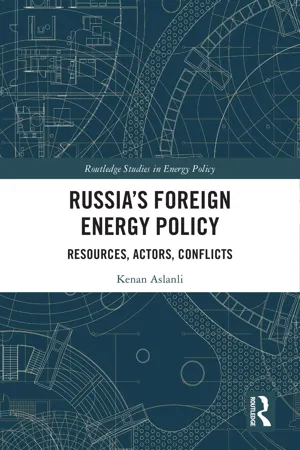
- 296 pages
- English
- ePUB (mobile friendly)
- Available on iOS & Android
About this book
This book examines Russia's multidimensional foreign energy policy and the emerging and ongoing conflicts with energy-consuming and transit countries.
Russia's Foreign Energy Policy examines whether the interdependence patterns shaped through various channels (such as foreign trade, investment, finance, technology, and social interactions) between Russia and energy-importing countries could prevent energy-based conflict. Drawing on semi-structured expert interviews, Kenan Aslanli challenges the one-sided conventional wisdom that focusses on foreign policy ambitions and overlooks the peculiarities of the energy dimension. Instead, Aslanli highlights the complexity of contemporary energy affairs using a holistic approach that goes beyond geopolitics. He examines various energy types such as crude oil, natural gas, and nuclear and considers a diverse range of actors which include energy companies and international organizations. Using examples from Europe, Asia, and the Middle East, Aslanli demonstrates how the Russian strategy of using energy resources as a tool or energy weapon for foreign policy goals has a diminishing return in the long run.
This book will be of great interest to students and scholars of energy policy, foreign policy, and Russian studies more broadly.
Frequently asked questions
- Essential is ideal for learners and professionals who enjoy exploring a wide range of subjects. Access the Essential Library with 800,000+ trusted titles and best-sellers across business, personal growth, and the humanities. Includes unlimited reading time and Standard Read Aloud voice.
- Complete: Perfect for advanced learners and researchers needing full, unrestricted access. Unlock 1.4M+ books across hundreds of subjects, including academic and specialized titles. The Complete Plan also includes advanced features like Premium Read Aloud and Research Assistant.
Please note we cannot support devices running on iOS 13 and Android 7 or earlier. Learn more about using the app.
Information
Table of contents
- Cover
- Half Title
- Series Page
- Title Page
- Copyright Page
- Table of Contents
- List of Abbreviations
- List of Figures and Tables
- 1 Introduction
- 2 Theoretical Framework
- 3 Conceptual Framework: Foreign Policy, Foreign Energy Policy and Energy Conflicts
- 4 Empirical Content: Economic Performance and Energy Resources
- 5 Major Actors of FEP: Energy Companies, Government, and Strategic Documents
- 6 Russia’s Energy Conflicts and Supply Interruptions Dataset (RECSID)
- 7 Motivations, Determinants, and Constraints of Russia’s FEP and Energy Conflicts
- 8 Conclusion and Policy Implications
- Appendices
- Appendix 1: Correlation Ratios of Energy Conflicts and Various Indicators
- Appendix 2: Indicators of the Energy Strategy of Russia for 2035
- Appendix 3: Ten Major Indicators for National (Economic and Military) Power (2019)
- Appendix 4: Examples from RECSID (Energy Conflict Tracker for Russia)
- References
- Index